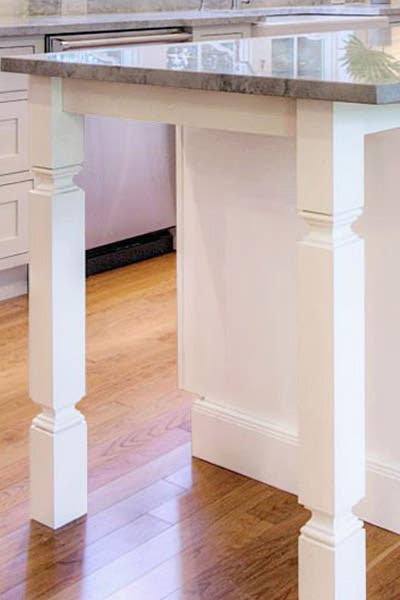Make The Most Of Adaptability with Flexible Legs For Kitchen Island Attributes
Important Elements to Consider When Picking Legs For Cooking Area Island
Picking the suitable legs for a cooking area island includes a cautious analysis of multiple aspects that can significantly influence both performance and visual appeal. As we explore these aspects, it becomes clear that each decision can have far-ranging implications for the general cooking area experience.
Material Options
When choosing legs for a cooking area island, recognizing the various product alternatives is vital for attaining both visual appeal and architectural honesty (Legs For Kitchen Island). The choice of material substantially affects not only the sturdiness of the island yet additionally its overall style and performance
Metal legs, frequently made from stainless steel or wrought iron, contribute a industrial and modern feeling while making certain durability and security. These products are immune to use and can support substantial weight, making them perfect for larger islands.
Another alternative is crafted materials, like MDF or plywood, which can be much more affordable while still offering a series of coatings. Nonetheless, they might not offer the same degree of security as solid wood or steel. Lastly, products such as acrylic or glass can develop a contemporary look, though they might need additional assistance to make sure stability.
Ultimately, the option of material for kitchen island legs must straighten with the preferred functionality and the total style of the cooking area.
Style and Layout

When thinking about style, the shape and finish of the legs are vital. Conical legs can supply a feeling of agility and sophistication, while thicker, a lot more durable legs can communicate stamina and security. Furthermore, the surface-- be it painted, stained, or natural-- should complement the cabinetry and kitchen counter products to develop a unified appearance.
Additionally, the style of the legs can likewise reflect personal preference. Custom-made or ornamental legs, such as those featuring elaborate carvings or one-of-a-kind geometric forms, can act as centerpieces, adding personality and character to the kitchen area. Ultimately, the appropriate selection will not only boost performance however also boost the visual appeal, making the kitchen island a standout attribute of the home.
Height Considerations
Picking the proper height for cooking area island legs is vital, as it directly influences both performance and comfort. The standard elevation for a kitchen island typically varies from 36 to 42 inches, aligning with usual counter top elevations. A 36-inch elevation is ideal for cooking and cooking, enabling comfortable usage of kitchen area devices and tools. Alternatively, a height of 42 inches is often liked for islands intended for bar seats, accommodating taller stools and supplying a laid-back eating experience.

It is additionally necessary to represent users' choices and elevations. Customizing the elevation can make sure a comfortable experience for all household members, making the cooking area island a much more practical and enjoyable area.
Weight Support
Making certain sufficient weight support for kitchen area island legs is vital for both safety and security and functionality. The cooking area island typically offers several objectives, including food prep work, dining, and added storage, requiring a durable support framework. When selecting legs, it is vital to consider the general weight capacity needed based upon the island's intended use and the products that will be positioned on it.
The selection of material for the legs plays a substantial role in their weight-bearing abilities. Strong timber, metal, and durable compounds generally offer premium strength compared to lighter products. In addition, the design of the legs-- whether they are directly, tapered, or have a pedestal type-- can affect their ability to distribute weight successfully throughout the framework.
Moreover, the leg placement must be purposefully intended to enhance stability. Legs positioned at the corners or with a broader base can much better sustain heavier loads. Always seek advice from the supplier's specifications concerning tons limitations to make sure that the legs can maintain the desired weight without endangering safety. In summary, selecting kitchen island legs with sufficient weight support is vital for producing a practical and risk-free culinary area.
Setup and Maintenance
Proper installment and maintenance of cooking area island legs are vital for ensuring durability and stability. This commonly involves safeguarding the legs to the island base using proper fasteners, making sure that the legs are level and lined up.
As soon as set up, routine maintenance is essential to preserve the honesty discover this and appearance of the legs - Legs For Kitchen Island. For wooden legs, routine cleaning with a moist towel and application of suitable timber gloss can prevent dampness damage and preserve their coating. Steel legs may need a mild cleaning option to get rid of grease and gunk, complied with by a dry towel to stop rust development
In addition, evaluate the legs on a regular basis for signs of wear or damage, such as fractures or loosened joints. Tightening up screws or screws as needed can likewise extend the life expectancy of the legs. By adhering to these installment and maintenance techniques, house owners can guarantee that their my link cooking area island stays sturdy and aesthetically appealing for many years to come.
Conclusion

Aesthetic comprehensibility is critical in picking the design and design of legs for a kitchen area island, as these components significantly affect the total setting of the room. Tapered legs can provide a feeling of lightness and sophistication, while thicker, more durable legs can communicate strength and security.Choosing the proper elevation for kitchen area island legs is crucial, as it directly impacts both performance and comfort. In summary, selecting kitchen island legs with appropriate weight assistance is essential for developing a functional and secure culinary room.
In verdict, selecting legs for a cooking see here now area island demands mindful factor to consider of numerous aspects, consisting of material options, style, elevation, weight assistance, and setup.